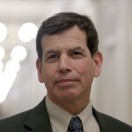
An American chemist, and a Japanese chemist who has lived and worked in the United States for the past 50 years, were among those named today as winners of this year’s Nobel Prize in Chemistry.
Richard Heck, an American who did much of his work at the University of Delaware, was awarded the prize, along with Ei-ichi Negishi, a Japanese citizen who has long been affiliated with Purdue University in Indiana, and Akira Suzuki of Hokkaido University in Sapporo, Japan.
The three are sharing this year’s prize for their development of laboratory methods that help chemists build complex molecules out of carbon atoms. Specifically, these methods allow scientists to attach carbon atoms to one another in precise configurations more efficiently than was previously possible. This process is called “palladium-catalyzed cross coupling” because it uses the element palladium to get normally reclusive carbon atoms to react with one another.
Palladium-catalyzed cross coupling is used in research worldwide, as well as in the commercial production of pharmaceuticals and to make molecules that are used in the electronics industry. The so-called Heck's reaction in particular has been used to synthesize such compounds as morphine; the cancer drug Taxol; a widely used herbicide; certain steroid hormones; and the poison strychnine.
Heck worked at Hercules Co., in Wilmington, DE—a producer of adhesives and other organic chemicals—in the 1950s, then moved to the Department of Chemistry and Biochemistry at the University of Delaware in 1971, where he remained until retiring in 1989. While at the University, his work was supported with more than $500,000 in research grants from the National Science Foundation (NSF). The Nobel committee’s recognition of the importance of his accomplishments and their great value to society is a wonderful reminder of the value of these and other Federal investments in basic research.
Co-winner Negishi came to the University of Pennsylvania on a Fulbright Scholarship and obtained his Ph.D. degree in 1963. He did a postdoc at Purdue University starting in 1966, after which he took a position at Syracuse University in 1972. In 1979 he was invited back to Purdue University as a full professor.
The eponymous Negishi reaction is used as a central step in the synthesis of laboratory-produced discodermolide, a poison created in nature by a marine sponge that attacks cancer cells in the same manner as Taxol—one of the world’s most frequently used cancer drugs—and may someday be used as a chemotherapy drug. Negishi has received approximately $3.5 million in funding from the NSF and the National Institutes of Health.
Congratulations to the winners, and to the Federal agencies and peer reviewers who recognized the seminal value of their work early on!
Rick Weiss is Director of Strategic Communications and a Senior Policy Analyst in the White House Office of Science and Technology Policy


